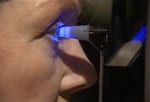Laser surgery has become increasingly popular as an intermediate step between medications and traditional glaucoma filtration surgery. Selective Laser Trabeculoplasty (SLT) is a relatively new laser treatment for open-angle glaucoma. SLT uses short pulses of low energy laser light to target melanin-containing cells in a network of tiny channels, called the trabecular meshwork. The objective of the surgery is to help fluids drain out of the eye, reducing intra-ocular pressure that can cause damage to the optic nerve and loss of vision.
The selective technique is much less traumatic to the eye than Argon Laser Trabeculoplasty (ALT), which has been the standard laser procedure. ALT can cause tissue destruction and scarring of healthy cells in the trabecular meshwork structure. SLT reduces intra-ocular pressure without this risk. SLT can be used to effectively treat some patients who could not benefit from ALT. This includes patients who have already been treated with ALT.
Although your doctor may suggest laser surgery at any time, it is often performed after trying to control intra-ocular pressure with medicines. In many cases, you will need to keep taking glaucoma drugs even after laser surgery.
SLT is for those:
- who have been diagnosed with glaucoma
- whose doctor has determined that SLT is appropriate for controlling their intra-ocular pressure
What to expect on procedure day:
Your treatment will be performed in a specially equipped laser room. It does not require a surgery center. Once you have been checked in and settled comfortably, drops will be used to numb your eye; no injections or needles are used. When your eye is completely numb, an eyelid holder will be placed between your eyelids to keep you from blinking.
Your doctor will hold up a special lens to your eye as a high-peak power beam of green light is aimed at the lens and reflected onto the meshwork inside your eye. You may see flashes of bright green or red light. The laser will selectively target melanin-containing cells, resulting in increased fluid outflow. You will not feel any pain during the procedure. It takes 10-20 minutes.
Your eye pressure will be checked shortly after your procedure and drops may be prescribed to alleviate any soreness or swelling inside the eye. You should relax for the rest of the day. Follow-up visits are necessary to monitor your eye pressure.

While it may take a few weeks to see the full pressure-lowering effect of this procedure, during which time you may have to continue taking your medication, many patients are eventually able to discontinue some of their medications. Most patients resume activities within a few days.
Realistic expectations:
The effect of the surgery may wear off over time. Serious complications with SLT are extremely rare, but like any surgical procedure, it does have some risks. Going to a specialist experienced in SLT can minimize the risks.
If you and your doctor decide that SLT is an option for you, you will be given additional information about the procedure that will allow you to make an informed decision about whether to proceed. Be sure you have all your questions answered to your satisfaction. If you would like more information about this procedure you can contact the office for additional information.


